FISHING METHODS IN JAPAN
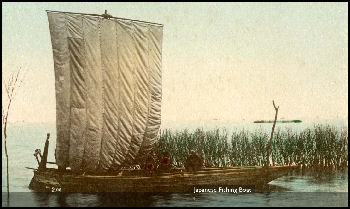
19th century fishing boat Chosi fishing port in Chiba is known for producing the best fish catches in Japan. Many of the fishermen head out at night and use handlines — 400-long ropes with 60 hooks bated with squid that reduce overfishing — which are positioned around dawn and left out for a couple of hours. The fish are brought in in the morning and auctioned off in a fish markets that are usually closed by noon. One of the specialities of the area is golden-eyed snapper, a bright red fish with brilliant yellow eyes.
Lookbox fisherman in Suruga Bay use a device which looks like a cheerleader megaphone to locate fish in the shallow part of the sea. The "lookbox" has a piece of glass in it, which the fisherman look through to seas the shallow sea bottom. The fishermen use spears to catch fish and a tool resembling a giant dentist probe to get crabs out of their hiding places where they can be scooped up by small nets. [Source: David Doubilet and Eugenie Clark, National Geographic October 1990]
Describing a traditional method called agiya fishing, Akira Anzai wrote in the Yomiuri Shimbun, “Only one group in the nation still practices a herd fishing method known locally as agiya--the Kuniyoshigumi on Irabujima island in Okinawa Prefecture. The method was developed by fishermen in Itoman on Okinawa's main island more than 100 years ago. It spread to the Oki Islands in Shimane Prefecture and the Izu Islands chain, but today agiya has disappeared--except for on Irabujima. [Source: Akira Anzai, Yomiuri Shimbun, July 2012]
“Today, the Kuniyoshigumi consists of 14 fishermen, called uminchu in the local dialect, who work from sabani, small traditional boats, and a mother vessel that carries their catches. Agiya fishermen first spread an eight-by-30-meter sodeami fishing net on coral reefs and place a 10-meter-deep bag net at the center.Some of the fishermen dive in the sea and herd the fish into the bag net using sticks about three meters long. The sticks have shiny yellow plastic tape on one end and chains on the other, presumably to frighten the fish into entering the bag net. The fish they pursue is the double-lined fusilier, called gurukun locally, a popular fish found in Okinawan waters.
“However, the traditional fishing method is under threat because the fishermen are aging and there is a shortage of successors. The average age of the fishermen is 68, with the oldest 78. "Young people shun herd fishing because it's dangerous," said Masao Kuniyoshi, 61, the head of the Kuniyoshigumi. He said the group only catches about one-third of the gurukun it caught 20 years ago using the agiya method. In 2011, 81.3 tons were landed, according to the Irabu fisheries cooperative. "I don't think agiya will be around much longer," Kuniyoshi said.
Websites and Resources
Links in this Website: FISHING IN JAPAN Factsanddetails.com/Japan ; BLUEFIN TUNA FISHING AND JAPAN Factsanddetails.com/Japan ; TSUKIJI FISH MARKET IN TOKYO Factsanddetails.com/Japan ; TRADITIONAL FISHING IN JAPAN Factsanddetails.com/Japan ; PEARLS AND JAPAN Factsanddetails.com/Japan ; SEAFOOD IN JAPAN Factsanddetails.com/Japan ; SUSHI Factsanddetails.com/Japan ; FUGU (BLOWFISH) IN JAPAN Factsanddetails.com/Japan ;
Good Websites and Sources on Fishing: Good Photos at Japan-Photo Archive japan-photo.de ; Ministry of Agriculture, Forestry and Fisheries maff.go.jp/e ; Statistical Handbook of Japan Fisheries Section stat.go.jp/english/data/handbook ; 2010 Edition stat.go.jp/english/data/nenkan ; News stat.go.jp
Good Websites and Sources on Blue Fin Tuna Fishing : Northern Blue Fin Tuna fishbase.org ; Southern Blue Fin Tuna fishbase.org ; Wikipedia article on Blue Fin Tuna Wikipedia ; Blue fin Tuna Fishing Methods content.cdlib.org ; Mediterranean Blue Fin Tuna Aquaculture eeuropeanrussianaffairs.suite101.com ; Southern Bluefin Tuna Aquaculture sardi.sa.gov.au/aquaculture ; Blue Fin Tuna Farming Off Spain uni-duesseldorf.de
Tsukiji Fish Market in Tokyo : Tsukiji Market site tsukiji-market.or.jp ; Essay on Tsukiji aboutjapan.japansociety.org ; Wikipedia Wikipedia ; Tsukiji Research people.fas.harvard.edu ; Japan Guide japan-guide.com Getting There: Best Japanese Sushi google.com/site/bestjapanesesushi ; Photos: Tsukiji Tour http://homepage3.nifty.com/tokyoworks/TsukijiTour/TsukijiTourEng.htm
Ama, Female Divers
Ama are women divers who collect various kinds of sea food in coastal waters from the ocean floor. They dive up to 60 feet, up to 75 times a day. Women are chosen for this job because they have more body fat to insulate them in the cold water than men.
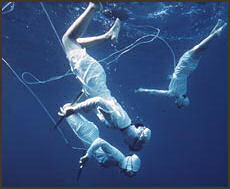
The Ama specialize in gathering abalone. They also collect “sazae” (wreath shells), lobster and “tengusa” seaweed. For years they were employed by the cultured pearl industry to collect oysters from natural beds around Japan. But these days they are no longer needed for that because most pearls today are cultured pearls that come from farmed oysters.
In the old days Ama often dove topless or wore traditional white cotton diving togs. They collected abalone for the Emperor’s enthronement ceremony and were depicted in many Edo-period woodblock prints with bare breasts and combs in their hair. After World War II, many worked at night as entertainers and ama-geisha. In the James Bond film “You Only Live Twice”, ama help disguise 007.
Young ama used to go through a kind of initiations. To prove their strength they had to make deep dives and stay underwater until their lungs were bursting. Once they made the grade they were allowed to attend special festivals held in secret locations in which they swam and danced in the nude and wore long-nose Tengu masks.
Working Ama
The ama work in small teams and dive at their favorite diving spots just in sight of the shore from boats driven by their husbands, They usually stay underwater for less than a minute but sped four or five hours a day in the water.
The ama wear wetsuits and masks. They use hooks, hammers and crowbars to pry abalone loose and carry plastic abalone measures and small water tight drums. They spread white cream on their faces to protect them from the salt and sun and wear special goggles installed special apparatuses that keeps their eyes from popping out of their sockets due to the pressure.
Skilled ama can earn as much as $100,000 in 70 days of diving. When they are not working in sea, ama sometimes work in hills growing flowers and vegetables.
Ama Today
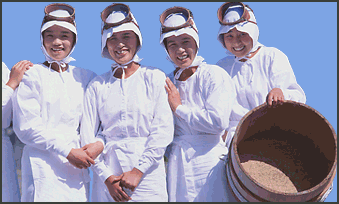
There are only a few hundred ama left in Japan today. Shirahama on the Boso Peninsula near Tokyo is one of their last strongholds. There are also communities in Aomori, Shizuoka and Kochi. Prefecture. Most of the divers are old. Few young women want to do it. See Shirahama, Boso Peninsula, Places
The ama in Shirahama collect around 15 tons of abalone a year, compared to 70 tons a year in the 1950s. Abalone supples have been depleted, mostly by poachers in scuba gear.
The Shirahama ama appear to love their work. One who was in her 60s told the Asahi Shimbun, “I love the sea. It helps keep me healthy and stops me from getting fat. My weight hasn’t changed from when I was a teenager and I’ve never caught cold in my life.”
The ama in Shirahama are regarded as bossy, and domineering. Some say their husbands used to stay as long as they could in distant ports to stay away from them. The head of the fishing cooperative in Shirahama told the Asahi Shimbun, “I have to deal with ama everyday — and I tell you, watch your step. They’re pushy, they’re gruff, they like dirty jokes...The women run things around here.”
The are a few female abalone divers left in western Kyushu. The often have puffy faces as a result of plugging their ears and holding their noses when they dive.
Octopus and Squid Fishermen in Japan
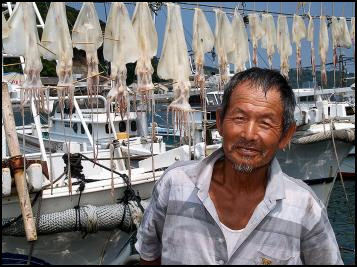
Japanese fisherman catch octopus in earthen jars that are tied together with ropes and dropped to the bottom of the sea. Octopus's apparently like dark places to crawl into the jars and hide so not bait or lid is necessary and the animals will stay in the jars even when they are hauled aboard a boat. On a good day about half on the jars that a fisherman has submerged will contain four or five pound octopuses. If an octopus is found with a leg missing it usually means it has eaten itself to stave off starvation. [Source: Bart McDowell, National Geographic, March 1974]
Squid are caught at night from squid jigger ships draped with bright lanterns that attract the squid which are caught with weighted and hooked lines that move up and down (jig) with the help of a hydraulic system. The waters between Japan and Korea are filled with lit-up squid boats as you will notice if you ever fly over the Sea of Japan at night.
Freshly caught squid are gutted the morning they are brought in and soaked in salt water and skewered with bamboo and hung to dry like laundry in the sun. Some places use squid-spinning machines tp get rid of excess water and speed up drying. Under the traditional method the squid are turned once before being collected in the evening and placed in storehouses. It is said the concentration of salt in the slated water and the amount of time the squid are soaked determines the flavor. Squid beaks are laid out on rack to dry in the sun.
Cormorant Fishing in Japan
Cormorant fishing is done at night, except after a heavy rain or during a full moon, from May 11th to October 15th on the Nagaragawa River (near Gifu) and the Oze River in Seki and from June through September on the Kiso River (near Inuyama). It also done in Kyoto, Uji, Nagoya and a couple other places.
The practice of cormorant fishing is over 1000 years old. These days it is performed mostly for the benefit of tourists. The ritual begins when a fire is set or a light is turned on over the water. This attracts swarms of trout-like fish called ayu. Tethered cormorants dive into the water and frantically swim around, gulping down fish.
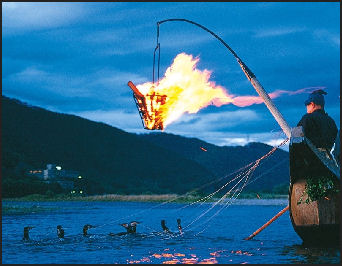
Metal rings and placed around the bird's neck to keep them from swallowing the fish. When cormorants' gullets are full they are hauled aboard the boat, and the still-moving ayu are disgorged on to the deck. The birds are then given rewards of fish, and thrown back in the river to repeat the process.
The boats are manned by four man teams: a master at the bow, in traditional ceremonial headdress, who manages 12 birds, two assistants, who manage two birds each, and a forth man, who takes care of five decoys. To get close to the action you need to take a viewing excursion on a tourist boats, often illuminated with paper lanterns.
Fishermen wear black so the birds can’t see them, cover their heads for protection against sparks and wear a straw skirt to repel water. Pinewood is burned because it burns even on rainy days. On fishing days the cormorants are not fed all day so they are hungry at fishing time. The birds are all caught in the wild and trained. Some can catch 60 fish an hour. After the fishing, the fish are squeezed out of the necks of the birds. Many visitors find this cruel but the fishermen point out that captive birds live to be between 15 and 20 while those that live in the would rarely live beyond five.
See Separate Article CORMORANTS AND CORMORANT FISHING factsanddetails.com; NEAR NAGOYA: CHUBU, GIFU, INUYAMA, MEIJI-MURA factsanddetails.com
See Royal Family
Abalone Fishing in Japan
Kippin dried abalone from the Tohoku region is made from abalone harvested in the wild. According to Iwate Prefecture's fisheries association, abalone takes about five years to grow large enough to be harvested.
Japanese abalone is highly prized at luxury Chinese restaurants in Hong Kong, the largest importer of Japan's marine products. Fook Lam Moon, a world-famous Cantonese restaurant in Hong Kong, said it has been using Kippin abalone for more than 90 percent of its abalone dishes to "achieve the highest level of flavor." "We can't think of substituting it [with a different product], " said the restaurant's Executive Director Daniel Chui, 36."I can't find anything better than Kippin abalone...I have to have it," one wholesaler told the Yomiuri Shimbun
Hoya are bred by attaching larvae to oyster shells hanging from rafts for three to four years.
Tsunami Destroys Abalone Industry

Cormorant fisherman The Yomiuri Shimbun reported: “The March 11 tsunami dealt a crippling blow to abalone fishing along the Tohoku region's Sanriku coast, sweeping tons of debris into the sea and destroying fishing vessels. It is expected to be years before abalone fishing in the area can resume, leading some retailers in China — a major consumer of abalone — to rush to secure supplies.” [Source: Yomiuri Shimbun, April 11, 2011]
Iwate Prefecture is known as a major producer of dried abalone, which is called Kippin abalone in China and elsewhere. Thick and tasty, it commands high prices as a luxury item. After the Great East Japan Earthquake, Yoshihama Bay in the Sanrikucho-Yoshihama district of Ofunato, Iwate Prefecture, was hit by a 15-meter-high tsunami that utterly destroyed a fishermen's cooperative building. Of 296 ships working before the disaster, only 11 survived.
Yoichiro Kikawada, production chief of the Yoshihama fishermen's cooperative: "The tsunami totally changed the coast. The abalone may have been totally destroyed." It will also take at least two to three years to remove the debris in the sea and rehabilitate the port. Overall, this means about 10 years before abalone fishing can return to full strength, the association said.
As wholesale prices soar, the menu price of a small abalone had jumped from 550 Hong Kong dollars (about 6,000 yen) to H.K.990 dollars as of April 1. "Most retailers in Hong Kong have a year's stock [of abalone], but they'll panic about getting dried abalone if fishing can't resume anytime soon," a spokesperson for the exporter said. "I know immediately whether abalone is Kippin because I can smell its distinct aroma when I cut it," a 63-year-old company president and regular customer of the restaurant said. "It's disheartening to think I might not be able to eat it no matter how much I pay."
Oysters in Japan
Oysters from Hiroshima Prefecture account for about 60 percent of Japan’s catch. At the port there fishing vessels leave at 4:00am and arrive 10 minutes later at the oyster beds. There the ship’s crane is used to pull up the oyster-covered wire cages from the sea. Oysters can be harvested at a rate of up to 60,000 an hour. They are soaked in seawater for 24 hours to clean them. The are shucked with a hook-shaped tool mainly by women in rubber gloves and hairnets. Unshelled oysters are steamed for a few minutes in white wine and served at restaurants in the area.
The Jigozen oysters caught at Jigozen Port in Hatsukaichi are famous throughout the country. One oyster farmer told the Yomiuri Shimbun. “The sea off Jigozen provides good quality phytoplankton for the oysters to feed on. That’s why they are so tasty...At the peak of the oyster season in January and February well-fed oysters become so fat they nearly pour form their shells.”
Wakame Seaweed
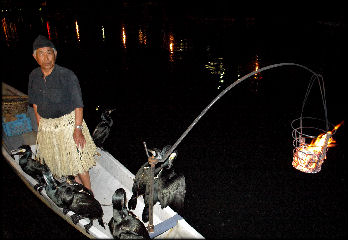 Iwate Prefecture produces the most wakame in Japan. In the autumn fisherman prepare ropes to raise the seaweed, which is grown through the winter and harvested in the spring. Cultivation usually starts in early August by sinking bundles of strings seeded with wakame spores into the sea.
Iwate Prefecture produces the most wakame in Japan. In the autumn fisherman prepare ropes to raise the seaweed, which is grown through the winter and harvested in the spring. Cultivation usually starts in early August by sinking bundles of strings seeded with wakame spores into the sea.
The strings on which the wakame is cultivated are twisted around thick ropes that are set into the sea and fixed to buoys between late October and November, when the spores begin to develop. The fast-growing wakame will be ready to harvest next spring.
It takes one month to prepare new ropes for cultivating the seaweed. If the operations are delayed, the growth of the wakame will be affected.
Seaweed Gatherers in Japan
Describing wakame gatherers off the Omoe Peninsula, near in Miyako in Iwate Prefecture, Masanori Genko of the Yomiuri Shimbun, “Fishermen leaned way out over the sea from their tiny fishing boats raking in strands of wakame seaweed with long sickle-tipped poles. They deftly swept the dark green, slippery plants onto their boats off the rocky coastline near Todogasaki Lighthouse, made famous by Keisuke Kinoshita's 1957 classic film “Yorokobi mo Kanashimi mo Ikutoshitsuki” (Times of Joy and Sorrow). The small boats tilted precariously when the fishermen reached out to scoop up the wakame. [Source: Masanori Genko, Yomiuri Shimbun, June 2011]
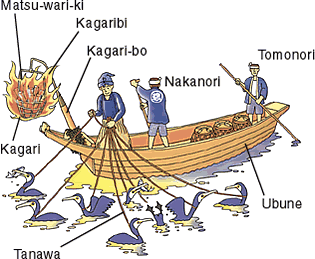
Omoe Peninsula, the easternmost point of Honsh has traditionally been a major wakame farming area. The tsunami that followed the March 2011 earthquake however destroyed many of the Omoe fishery cooperative's fishing boats--only 14 vessels out of a fleet of 814 were left functional. Including the secondhand purchases, the cooperative managed to cobble together 68 boats so people could get back to work.
With so few boats, the cooperative decided fishermen from two or three households should work together on the same boat and share profits. Hiroaki Yamazaki, who took part in the wakame harvest, said, "Fishing is a job where your earnings depend on the amount of work you do. At first I was a little uneasy about sharing a boat with another fishermen." The tsunami swept away Yamazaki's house and boat--both of which had been handed down for generations. He thought of giving up at one point, but he said he felt like his old self again when he got back out on the ocean.
But Yamazaki is one of the lucky ones. Quite a few fishermen have abandoned their careers. The Omoe fishery cooperative used to boast the largest yearly haul of farmed wakame in the country. But in a survey at the end of April, 58 out of 181 households engaged in wakame farming said they were hanging up their wakame poles for good. To ensure a successful harvest next spring, preparations need to be completed by the end of July. However, since the central government has yet to decide on measures to support disaster-stricken areas, the future of the wakame harvest is by no means certain. "We'll definitely be back," said 72-year-old Ryuichi Ito, head of the cooperative. "Of the 450 households in the Omoe district, about 90 percent make their living through fishing. If our community is going to survive, we'll have to keep sharing boats for the time being," he said.
Harvesting Herring Roe
Herring roe is a popular New Year delicacy. Much of the herring is harvested in waters off the Alaskan island of Sitka. During a fishing season that can last less than three hours, fisherman can make up to a half a million dollars for a single 400 ton catch.
Only 52 boats have licenses to catch herring and these license sell for up to $210,000 a piece. To locate and track the schools of herring the fisherman use sophisticated echo sounders and spotter planes. Once a school has been located competing fishing boats jockey for position as they try to encircle the school with a net and pump the fish on to the boat.
One fisherman, who netted 400 tons of fish but was only to pump a 100 tons aboard his ship, told Krakauer: "the fish started running straight for the bottom and we couldn't stop them. The net when sown and then the boat started going over. The rail went over, and there was water on the deck halfway up the hatch coming. When you see something like that happening you don't hesitate. We cut the lines, the bridles — cut everything loose. Otherwise we would have gone to the bottom with the fish."
Eels and Japan
In December fishermen with wet suits, head lamps and meter-wide circular nets gather at the mouth of the Hishidagawa River in Osaki in Kagoshima Prefecture to catch baby eels. The season extends through March but fishermen gather at this time because the prices are the highest. The eels that are caught are turned over to eel farms that raise them.
After years and years of looking, in 2006 Japanese scientists finally found what they think is the main spawning site for Japanese eels in the Pacific ocean west of the Marianas Islands. Last updated April 2012
Image Sources: 1) Visualizing Culture, MIT Education 2) 3) Mikimoto Pearl Museum 4) 6) 7) Ray Kinnane 5) 8) Gifu government 9) JNTO
Text Sources: New York Times, Washington Post, Los Angeles Times, Daily Yomiuri, Times of London, Japan National Tourist Organization (JNTO), National Geographic, The New Yorker, Time, Newsweek, Reuters, AP, Lonely Planet Guides, Compton’s Encyclopedia and various books and other publications.
